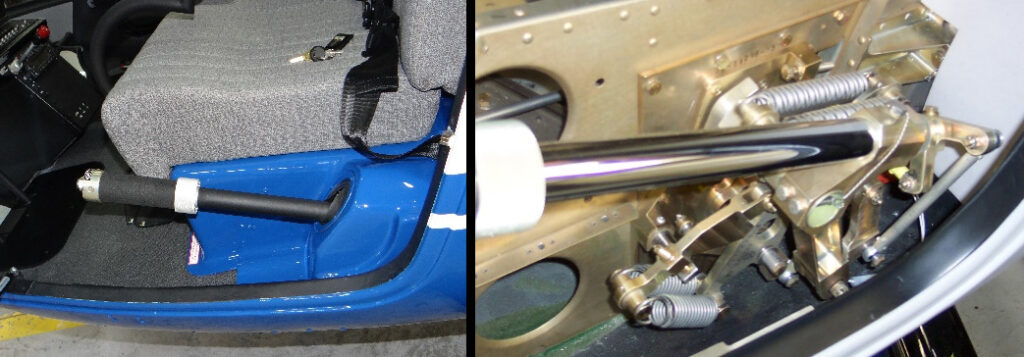Effective Correlator Operations

Enstrom occasionally get questions from pilots about why their correlator doesn’t seem to be effective. Most of the time we find that this issue comes from a misunderstanding of how it works and how to properly use it.
The major difference between the correlator operation and governor operation (in piston engine helicopters) is that with the correlator the throttle twist grip must not be allowed to turn during flight, and with a governor the throttle must turn to allow the governor to control RPM during collective and power changes.
The correlator is a pretty miraculous device, I have always thought that the designers (Peter Cross & Ron Young) should have gotten the Einstein award, or at least the Rube Goldberg award! But what is amazing about it is how well it works despite how complicated it is; if you let it do its job as it was designed.
Years ago, the flight manuals used to instruct the pilot to set the engine RPM at 2350 and pull pitch, the idea being that the correlator would bring the RPM into the green as the helicopter came off the ground and into a hover. The problem with this procedure is that the helicopters are all a bit different and the starting RPM for this procedure could be anywhere from 2000 RPM to 2500 RPM, and there is usually a bit of time after liftoff when the nose is bobbing all over the place as the pilot tries to get the RPM under control.
The primary benefit to this procedure was that it allows the pilot to pick the helicopter directly into a hover and largely avoid the tap-dance that Enstroms are so well known for. (This will be a topic for a future discussion). But this procedure gives me a great amount of heartache for several reasons. One is that on the later helicopters with the low rotor RMP horn, it scares the unsuspecting passengers, and for another it has the effect of suggesting to the pilot that RPM isn’t a primary concern. In a piston engine helicopters RPM control is one of the most important factors for safe operation. There have been plenty of accidents, even in Enstroms from the pilot letting the RPM get too low.
The proper procedure to pick up a correlated Enstrom into a hover is to set the throttle twist grip friction so there is some friction on the throttle, enough that the throttle will not turn on its own, and then run the RPM up into the green before beginning to lift the collective. As the collective is raised the correlator will increase the throttle requiring the pilot to reduce throttle to prevent exceeding RPM limits. The pilot should reduce throttle as necessary to maintain RPM in the green as the helicopter lifts into a hover.
As the helicopter oleo struts are extending, the ground bounce should diminish. The pilot can hesitate as the helicopter is almost light on the skids, make final RPM adjustments with the throttle before lifting into a hover. By controlling the RPM as the helicopter is lifted off the ground the pilot has correlated the throttle to the helicopter for that day, wind condition, and gross weight.
It is important to set the throttle friction so that the throttle will not turn on its own when the collective is moved. If the throttle is allowed to move, (other than minor trimming by the pilot) the throttle will become uncorrelated from the collective.
It is important to remember that that the correlator is mechanical and can’t adjust for changes In the power requirements due to things such as wind direction and tail rotor requirements so as the helicopter is maneuvered, the throttle may have to be tweaked to maintain RPM. The easiest way to control RPM is to make very slight throttle adjustments if needed and wait a moment to see what the RPM does. The smoother the helicopter is flown, the better the correlator can keep up.
The pilot can make a simple check of the correlator to see if it needs to be adjusted. Transition into a normal gentle departure from a hover at low green RPM. The correlator should maintain the RPM within the green arc during the departure and into forward flight, even with collective changes. Fly the downwind at high RPM and reduce manifold pressure to about 18 inches and then fly a normal approach to the runway. The correlator should maintain RPM within the green arc without the RPM dropping out of the green arc.
Having to make small changes to the correlator adjustment by a technician after engine service may be required and is normal, and will be the subject of a future discussion.
This method for taking off into a hover accomplishes several things:
- It prevents the low rpm horn from sounding.
- The pilot knows exactly where the RPM is during lift off and eliminates the scrambling to get the RPM under control.
- It correlates the throttle to the collective and RPM at the present flight conditions, gross weight, density altitude, and wind conditions.
The magic is that once the pilot has correlated the throttle to the collective position and RPM, the correlator can control the throttle automatically. This is why running the throttle into the green and modulating the RPM as the collective is raised is important to the operation of the correlator.
Bayard duPont is the Senior Technical Fellow Product and Technical Representative at Enstrom Helicopter.
About Enstrom Helicopter
From Rudy Enstrom’s early designs in 1943 to initial testing in a Michigan Quarry in 1957 to aircraft operating on six continents, Enstrom Helicopter Corporation has maintained a reputation for safety, value and performance. Based in Menominee, Michigan and proudly made in the United States, Enstrom has a rich history for design innovation. The goal is to provide helicopters to the customer’s exact specification and deliver support and maintenance worldwide.